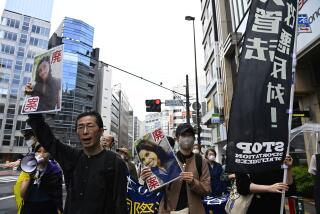HEALTH : Japan Steps Up Efforts to Teach Uninformed Public About AIDS
- Share via
TOKYO — Japan reported its first case of AIDS seven years ago, but the recent “Ginza Panic” demonstrates how far health officials still have to go in raising public awareness of the deadly disease.
It began with a beautiful Japanese hostess named Rika. She was 26 years old. She worked in the tony Ginza district of Tokyo at a first-class club called Bulubon, where a bottle of whiskey cost upward of $750. In January, she died.
Before her death, she slept with countless men, disappearing before dawn, leaving this message scrawled on the hotel room mirror in lipstick: “Welcome to the world of AIDS.”
Whether Rika actually was afflicted with acquired immune deficiency syndrome is not known. But in the ensuing bedlam, the club was deluged with calls that indicated ignorance of even the most basic knowledge about AIDS. Clients demanded, for instance, that all drinking glasses be sterilized, although the disease is known to be spread only through sex, blood transfusions or similar exchanges of bodily fluids.
Last year, a government poll showed that 60% of respondents mistakenly believed that AIDS could be spread by mosquitoes. And earlier this month, a survey of 10,000 Japanese conducted jointly by the Ministry of Health and Welfare and the World Health Organization found that 75% of those engaging in extramarital affairs did not use condoms or other measures to ward off AIDS.
“The results of the survey are frightening. I had no idea that there were so many people in danger of being infected,” said Tsunetsugu Munakata, a Tsukuba University professor who helped conduct the study.
Another survey found that only 31% of Japanese college students who were questioned realized that condoms were effective against AIDS, compared with 61% of Americans.
Health specialists warn that many Japanese still regard AIDS as a “foreigners’ disease” that has “little to do with me.”
And some public education efforts have perpetuated that cliche. Earlier this year, the government-funded AIDS Prevention Foundation issued posters featuring a Japanese man shielding his eyes with a passport. The caption read: “Have a good time. But be careful of AIDS.” The poster was withdrawn after widespread criticism that it was promoting both overseas sex tours and the illusion that AIDS is a foreigners’ disease.
In fact, the incidence of AIDS in Japan is still relatively low: In 1991, there were 453 confirmed patients and 1,955 carriers of the human immunodeficiency virus, or HIV, in a nation of 120 million. But that number had more than doubled over the previous year, and some health officials estimate that the real number could be 20 times higher.
As the reality of the AIDS threat begins to sink in, the government has begun stepping up its educational efforts. Last week, a Cabinet committee announced that it would strengthen its AIDS countermeasures for the first time in five years, deciding to offer confidential AIDS tests, promote research and adopt more comprehensive counseling programs. The Tokyo government and private organizations combined now employ only about a dozen AIDS counselors for a city of 12 million.
Private organizations are also pitching in. The HIV Human Rights and Information Center held an AIDS Awareness Day last December and received 1,771 calls from people seeking counseling. That boosted the total number of calls last year to 2,200, compared with 300 in 1989.
Experts say this year will mark a key turning point for the Japanese. Unless they succeed in raising the level of awareness and persuade people to avoid high-risk behavior, the number of cases could spiral to 1 million in the next few years, they say.
More to Read
Sign up for Essential California
The most important California stories and recommendations in your inbox every morning.
You may occasionally receive promotional content from the Los Angeles Times.














